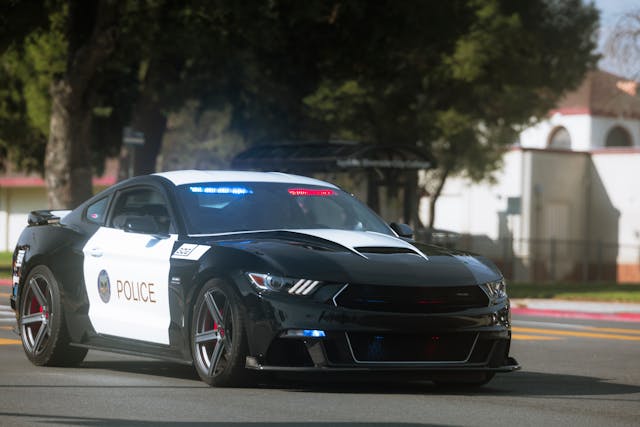Trooper Bobby Coggins was shot and killed by escaped convicts during a traffic stop. The tragic incident sparked a massive manhunt and legacy.
Trooper Bobby Lee Coggins was shot and killed by escaped convicts on September 14, 1985, after initiating a traffic stop, when one fugitive used his own gun to fatally shoot him in the head.
I remember the first time I read about officers who died in the line of duty. It hits differently when you realize how ordinary the moment must have felt right before tragedy struck. In the story of Trooper Bobby Coggins shot and killed by escaped convicts, that ordinary moment was a simple traffic stop; something he had likely done hundreds of times before.
But on that September evening in 1985, the world tilted. A calm roadside check turned into chaos, and within seconds, a young officer’s life ended; not because of recklessness, but because of how unpredictable desperation can be.
At americanworthy.com, we explore stories that highlight how modern practice meets human empathy; uncovering the human pulse behind every historical moment, no matter how tragic.
This isn’t just a headline or a dusty police report. It’s the story of a man, two fugitives, a brutal confrontation, and a legacy that still whispers through law enforcement circles today. And as I try to piece it all together, I can’t help but imagine how fragile those few seconds must have felt; the air thick with routine and danger at the same time.
Article Breakdown
The Stop That Turned Deadly
The Context: Escaped Convicts on the Run
In late summer 1985, two convicts; William Richard Bray and Jimmy Rios, both just 23; escaped from the Franklin County Jail in Arkansas. They didn’t have a plan; they had adrenaline, fear, and a stolen truck. Their escape set off alerts across state lines, and by mid-September, the two had made their way into North Carolina, hoping to disappear in the dense Appalachian foothills.
It was there, near Macon County, that Trooper Bobby Lee Coggins spotted a suspicious vehicle on the evening of September 14, 1985. The stop appeared routine; maybe a suspected DUI or a stolen car. Nothing out of the ordinary for a young trooper trying to keep the roads safe.
But nothing about that night would stay ordinary for long.
The Fatal Encounter
When Trooper Coggins pulled the vehicle over, he approached calmly; likely unaware he was dealing with two escaped prisoners. Dispatch soon confirmed his worst fear: the men inside were fugitives.
Within moments, everything spiraled. One of the men opened fire with a small .25-caliber handgun. Coggins drew his weapon, attempting to return fire, but the attack was relentless. The second fugitive lunged forward, grabbed the trooper’s own sidearm, and turned it against him.
A single shot to the head ended Bobby Coggins’s life on that quiet roadside. The convicts fled the scene, leaving behind not just a fallen officer, but a trail of rage, grief, and urgency that would soon ripple across the entire state.
The Manhunt That Followed
The killing of Trooper Coggins set off one of the largest manhunts North Carolina had seen in years. Within hours, more than 300 officers; state troopers, sheriff’s deputies, federal agents, and even volunteers; converged on the area.
Helicopters buzzed overhead. Search dogs scoured the terrain. Checkpoints dotted rural highways. The fugitives had fled into the Blue Ridge Mountains, a labyrinth of steep ridges, hidden valleys, and thick forest; perfect ground for running, but impossible to hide in forever.
For three tense days, search teams swept the area. Locals were urged to lock doors, stay inside, and report anything unusual. A bloodhound named Brandy eventually caught their scent, leading officers to a small wooded area where both men were hiding. Exhausted, disoriented, and surrounded, Bray and Rios surrendered without a fight.
Justice had caught up with them; but the loss had already been written.
Trooper Bobby Coggins: The Man Behind the Badge
Behind every officer’s badge is a person; a story, a heartbeat, a dream. Bobby Lee Coggins was only 26 years old when he died. He had been with the North Carolina Highway Patrol for just about a year, and before that, he’d spent two years as a seasonal park ranger with the National Park Service.
He was known as calm, disciplined, and kind. Friends described him as someone who believed deeply in service; not the badge itself, but what it represented: responsibility, integrity, and care for the public.
He wasn’t just an officer; he was a son, a brother, and a fiancé. The most haunting detail? Moments before the shooting, his fiancée happened to drive past the very scene of his stop; unaware that within minutes, her world would collapse.
Coggins had a future planned; marriage, a stable career, a life built on protecting others. That night, everything was taken in a flash.
His family, still in grief, turned that loss into remembrance, ensuring his name would be etched into the memorials that honor fallen law enforcement officers.
Legal Aftermath and Accountability
Trials and Sentencing
After their capture, Bray and Rios were charged with first-degree murder. The evidence was overwhelming. During the trial, witnesses and forensic investigators painted a clear picture of what had happened.
The court found both men guilty. In May 1986, they were sentenced to life imprisonment plus 93 years. For many, that sentence was symbolic; no amount of prison time could equate to the life lost, but it sent a message that violence against law enforcement would not be tolerated.
Even more chilling were later reports that the two bragged about the killing, referring to it as an “execution.” It’s the kind of detail that cuts deep; the kind that shifts a story from tragedy to something darker, something cruel.
Law Enforcement Response
The killing of Trooper Coggins sent shockwaves through the ranks. Departments across the South began reviewing officer safety protocols, especially concerning solo traffic stops in rural areas.
Several themes emerged:
- Backup policies were strengthened, ensuring that troopers rarely operated alone in high-risk zones.
- Weapon retention training became a stronger focus, emphasizing techniques to prevent suspects from seizing an officer’s firearm.
- Inter-agency coordination improved, making multi-county manhunts more structured and efficient.
Though there was no single sweeping reform credited solely to this case, it became part of a broader shift toward improving tactical awareness and officer survival training nationwide.
A Legacy That Endures
Decades later, Trooper Coggins’s story still circulates among officers as both a warning and a remembrance. It’s featured on memorial walls, in training academies, and in quiet roll-call tributes.
His death reminds new recruits of the fragile line between control and chaos; how even the most routine encounters can turn fatal in a heartbeat.
He’s remembered not only for his service but for his humanity; a young man who stepped into danger every day, believing in the power of order and decency. And though he’s gone, his story continues to echo through those who wear the same uniform today.
Contradictions, Tensions, and the Unanswered Why
Every tragedy leaves behind questions that never find peace.
Why did the convicts decide to open fire instead of running? Was it panic? Rage? A misguided idea of freedom?
Could backup have arrived sooner? Could different procedures have prevented the loss?
No one can say for sure. What’s clear, though, is that the line between life and death in law enforcement often comes down to seconds; and the unpredictability of human behavior.
There’s also the cruel irony: the weapon that symbolized Coggins’s duty to protect became the tool used to end his life. That single detail forces a reflection on control, vulnerability, and the paradoxes of authority in moments of crisis.
Comparative Snapshot
| Role / Figure | Age / Experience | Key Distinctions | Legacy / Fate |
|---|---|---|---|
| Trooper Bobby Coggins | 26, ~1 year patrol service | Young, dedicated officer | Killed in the line of duty |
| William Richard Bray | 23 | Escaped convict, shooter | Convicted, life + 93 years |
| Jimmy Rios | 23 | Escaped convict, accomplice | Convicted, life + 93 years |
| Bloodhound “Brandy” | — | Police tracker | Helped locate fugitives |
| Law Enforcement Team | ~300 officers | Multi-agency force | Captured both suspects within 3 days |
The contrast here is striking; youth on all sides, yet such vastly different paths. One dedicated to service, two driven by defiance.
Frequently Asked Questions
Q1: Who was Trooper Bobby Coggins? He was a 26-year-old North Carolina Highway Patrol trooper, known for his professionalism and kindness, who was killed during a traffic stop in 1985.
Q2: How was Trooper Bobby Coggins shot and killed by escaped convicts? He was conducting a routine stop when one fugitive opened fire. The other seized his weapon and fatally shot him in the head.
Q3: What happened to the convicts who killed him? Both William Richard Bray and Jimmy Rios were captured three days later and sentenced to life plus 93 years in prison.
Q4: What triggered the original stop? Coggins suspected a possible DUI or stolen vehicle and initiated a standard roadside check, unaware that the men were escaped prisoners.
Q5: Did his death lead to any policy changes? While not directly tied to a specific reform, his death became a pivotal case that influenced training on officer safety, weapon control, and backup response.
Key Takings
- Trooper Bobby Coggins was shot and killed by escaped convicts during what began as a routine traffic stop.
- The assailants used his own firearm, underscoring the dangers officers face in close-contact encounters.
- A massive manhunt involving over 300 officers and a tracking dog led to their capture three days later.
- Both convicts were sentenced to life imprisonment plus 93 years.
- Coggins was only 26, engaged to be married, and had less than a year on the job; a heartbreaking reminder of service and sacrifice.
- His death influenced conversations around officer safety, backup, and firearm retention.
- The story remains a lesson in vulnerability, courage, and the unpredictable nature of human confrontation.
Additional Resources
- Trooper Bobby Lee Coggins biography: A comprehensive biography and memorial reflection honoring his life, service, and sacrifice. (Details about his career, family, and the incident.)
- Trooper’s Killing Sparks Manhunt: An in-depth contemporary news report covering the immediate aftermath, manhunt, and community reaction. (Provides historical context and insight into the 1985 investigation.)



